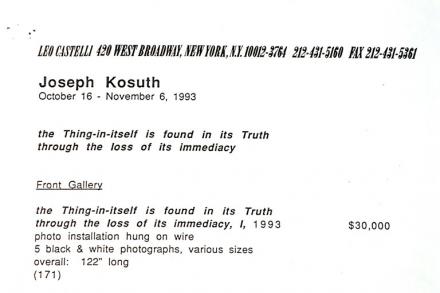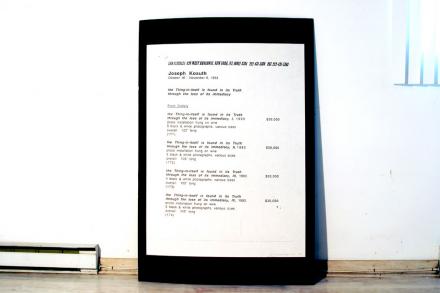
This work is a giant Xerox of the price list for Joseph Kosuth’s show at Leo Castelli Gallery in 1993. It’s a bit of an anthropological artifact. Leo Castelli is dead and the gallery is no longer open.
The work functions as a perfect market indicator. It strips the art down to it’s most basic which is a brand name (Joseph Kosuth) the description of the work, and its' price. Kosuth himself titled the series, the Thing-in-itself is found in its Truth through the loss of its immediacy I, II, III, IV, etc…
There are many subtle indicators in the title page pointing out that this is extra special conceptual art. You’ll notice a total disregard for the conventions of writing. The only two words capitalized in the title are, Thing and Truth, as well as the Roman numerals indicating the number in the series. So we know that this is about a thing and truth. The Roman numerals immediately give the work a learned, classical air of seriousness.
In any case, the title is really all one needs to begin a discussion about what is art and does it exist in the society, what is its’ use and does it have any special qualities? We see that the thing is in itself. I imagine that means it has no reference or relationship to any other thing. I guess the thing is a loner but wait; it’s a series of things in themselves so it’s not really a lone entity.
This gets away from the main point of my work; the price list and in a larger context Faux Conceptual Art. The piece is punk art. I challenged the master with a bit of duplicity and like Rauschenberg’s erasing De Kooning, I neutralized the meaning because of it’s exhaustion and in-authenticity.
Here’s a review from Art in America about brand name Joseph Kosuth;
Joseph Kosuth at Castelli - New York, New York - Review of Exhibitions
Art in America, March, 1994 by Raphael Rubinstein
“For those who think of Joseph Kosuth as inhabiting solely the lofty realm of Freud and Wittgenstein, this show was something of a shock. Walking past his groups of blown-up newspaper articles, you got to read about Lorena Bobbitt, Dr. Jack Kevorkian, Sarajevo, the destruction of rain forests and an Egyptian novelist jailed for eight years; you could also peruse syndicated cartoons such as Blondie and Doonesbury. All this was a far cry from installations like the one in which the artist covered every inch of Castelli's old Greene Street space with pages from Freud, though Kosuth's intellectual pursuits were still evident in the quotations, usually from Kafka or Robert Musil, that frame each sequence of articles and cartoons.
The works were simply presented, with each group of five or six variously sized photostats clipped to a length of wire like prints drying in a darkroom. The first quote in the show, from Hollywood mogul Samuel Goldwyn, set the tone: "Spare no expense to make everything as economical as possible." Even the way the bottoms of the photostats curled up during the course of the show (which carried the unwieldy title "The Thing-in-Itself is Found in Its Truth through the Loss of Its Immediacy") added to the stripped-down look of the work.
A typical piece began with James Joyce's famous quote about trying to awaken from the nightmare of history. It hung alongside an article on the unequal educations received by rich and poor Americans, a photograph showing the cleaning of the Lincoln Memorial by an African-American applying a brush to the white marble, and a Blondie cartoon in which Dagwood argues with his neighbor. The sequence ended with a quote from Kafka to the effect that "nobody would fight his way through here, least of all one with a message from a dead man." Although the work took several minutes to read, it didn't take long to identify Lincoln with Kafka's "dead man," and Stephen Dedalus, trying to wake up from history's nightmare, with the United States itself. For all their effective engagement with the issues of the day, these works could also be read autobiographically, conjuring up the clichéd image of the Conceptual artist who has nothing better to do than sit around reading the newspaper. The paper most frequently used was the International Herald Tribune, a reminder that Kosuth has spent much of his time in Europe, where Conceptual art has historically been better received than in the U.S. “ – from http://www.findarticles.com/p/articles/mi_m1248/is_n3_v82/ai_
Indeed, the most revealing part of the work, Joseph Kosuth Price List, are the prices of $30,000 dollars each. Just as the object is irrelevant so too are the thoughts behind the work. The only thing that matters is the price. Here we have the art market at it’s most basic. I’ll try and break it down. The Brand Name, (Joseph Kosuth) has an exhibition with the prestigious and reputable Castelli Gallery (venue conveys worth). The prices reflect the market position of the artist and have little actual relation to the cost of production of the work. This denies the handcrafted-ness of the art although there is an actual making of art objects. The pieces are photographs of newspaper articles, cartoons, quotes from books etc… there is an art object. The art object is minimally important but does need to be in some form that can be preserved. Things tend to lose their value if they disintegrate. Perhaps that's what Kosuth means by the thing-in-itself.
Maybe the titles of the works are an indication that by contemplating the juxtapositions of clippings that the meaning will be revealed to the viewer. It appears that the art reviewer thought that was the essence of Kosuth’s work.
What I see is something that could indicate the beginning of hypertext but for Kosuth as with most of the art world, online art and hypertext were not in their range of vision. What Kosuth did was “borrow” some techniques from Barbara Kruger and other Colab artists that were working in the 1980’s. It points out that the larger art world saw nothing wrong with a 1993 exhibition using 1980’s innovations. This was occurring while experimental artists began to work on the internet in order to go around a closed art market that had turned in on itself.
My project Faux Conceptual Art, was and is online as a website and also as a series of project proposals. The dynamic of Faux Conceptual Art is to critique the market and to discuss the idea of originality. It also talks about the demands within a capitalist society for originals and copies. This is another false dichotomy that was first proposed by Walter Benjamin in his essay, The Work of Art in the Age of Mechanical Reproduction. The larger issue of mechanical reproduction is how the meaning and value of an artwork is created and maintained. In an information society demand is created by attention on the network. More copies mean more attention. More attention can create value or promote a cause. The dialectic of copy and original is very old fashioned. It’s based on the idea of scarcity and it’s opposite, abundance. Old style market says scarcity creates value. New style market says demand creates value, information creates value. More is more or rather more is much, much more. The sense of originality within art has to do with creating new ways of seeing and perception. It also has to do with advancing the language of art. The stagnation within the art world has as much to do with the absolute power of the market above everything else. The art world is a closed language system. The writers and reviewers reinforce the prevailing styles. They verify that something has value. The logic of any market says that you can make a variation on a style that is already selling and you will be able to make money. There are very few people who will risk showing originality. Originality does not make money. In this market logic, something that is reproduced and widely distributed has more market recognition and therefore more value than an original. It also says that a brand name is more valuable than an original. This is the logic of logos. The trademark is the value.
My own position is much more radical. I have determined that creativity, the creative act of an artist, is where the true value resides. Everything beyond that is an attempt to capture the creative act. Neither the original nor the copy are anything other than an indication of the real value in art. In this case, I speak about the potential art than can be made from any proposal, instructions or set of ideas. This may be confusing but what it means is that the market stifles creativity by focusing on a finished object that can be put into circulation in the art market.
http://nujus.net/gh
http://www.artnetweb.com/projects/fauxcon/home.html

et tu...
The possessive of "it" does not take an apostrophe.